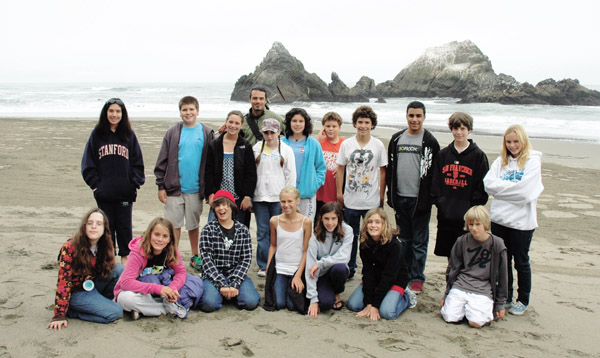A look into the creative mind of sand artist Andres Amador
MAY 2011 FEATURE
By Madison Allen, Chiara Arellano, Joseph Blair, Claire Donohoe, Guilio Chiappolini, Juliet Crome, Simon Crabill, Caroline Frost, Henri Geneste, Sabrina Hao, John Hassen, Marcus Narodny, Vinca Rivera, Eliza Ross and Emma Steinberg - from Hall Middle, Lycee Francais La Perouse, Manor, Marin Country Day, Mill Valley Middle, Park, Ring Mountain Day School, St. Raphael, White Hill Middle and Tam High Schools
 Sand, sand, sand. With sand comes sun bathing, sand castles, sculpting, or in the case of Andres Amador, sand designs. As FastForward reporters, we learned firsthand that making sand designs is way harder than it looks.
Sand, sand, sand. With sand comes sun bathing, sand castles, sculpting, or in the case of Andres Amador, sand designs. As FastForward reporters, we learned firsthand that making sand designs is way harder than it looks.
Amador starts another flower—first the circle, then the petals—making sure to keep them even. The wet sand beneath the Cliff House in San Francisco sticks to shoes and hands as we mimic Amador's design, some of us venturing out to make their own. Over an hour, a broad field of flowers slowly emerges from the tightly packed sand.
Andres weaves his way in between the designs with ease, commenting on this petal, or that design. He quipped, "You're an artist and the beach is your canvas. It's natural. You can go as big as you want…you don't need to use anything but a rake."
For the past six years, Andres Amador has been an earthscape artist. In this style of art, Andres uses rakes to carve designs in the sand. Inspired by the crop circles in England, he began designing organically, and from that foundation, his passion for sand art grew.
To complete the dramatic yet temporary design before high tide washes it away, Andres starts working an hour before low tide, giving himself about two hours to complete the project. Low tide is the best time to make this kind of art because it allows for the most sand space on the beach. An extreme low tide to occurs about once a month, which provides an enormous canvas and is the best time to design.